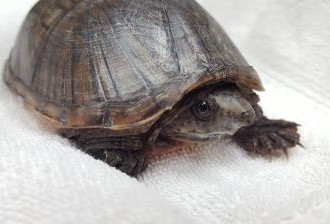
May is a special month for turtles and tortoises as World Turtle Day is celebrated every year on May 23rd, so we thought it would be fitting to feature the musk turtle as our Animal of the Month for May. But now May is coming to a close today, so we have to say goodbye to the musk turtle. If you were following us all month on Twitter @ExoticPetVets, we hope you enjoyed our tweets all month long about this turtle who is found in Ontario and Quebec. If you missed any of our tweets, we have compiled a summary for you. Did you know?:
- Musk turtles are native to Ontario, Quebec, the U.S. East and parts of the American Midwest south through to Texas.
- In Ontario and Quebec, the musk turtle’s range is mainly in the southern part of both provinces. But they are mostly found near the southern edge of the Canadian Shield.
- In Ontario, musk turtles in Ontario are considered to be a threatened species.
- Humans are the biggest threats to musk turtles through habitat destruction, water pollution, boating activity, fishing lines, road mortality, poaching and wildlife smuggling.
- NEVER take musk turtles from the wild to keep as pets! It is illegal and threatens wild populations. If you want to bring a musk turtle into your family, you must do so through a reputable breeder.
- Other threats to musk turtles include predation by raccoons, droughts and high water levels which can overwhelm nesting sites.
- Musk turtles are mostly aquatic and inhabit shallow lakes and rivers with a slow-moving current. They also live in ponds and marshes.
- Despite spending most of their time in the water, did you know that musk turtles aren’t very good swimmers? They will walk along the bottom of the body of water to get from place to place.
- Musk turtles are also not very good at travelling on land. But they will do so if the body of water where they have made their home dries up and they need to find another body of water. This puts them at risk for road mortality.
- Oddly, musk turtles have been known to climb trees and have been seen resting in trees as high as six feet or more above the water!
- The musk turtle is often known as the common or eastern musk turtle.
- If you guessed that the musk turtle’s name is a nod to a bad smell, you would be right. The musk turtle is also known as the stinkpot turtle because he will emit a foul odour when he is disturbed and feels threatened.
- Musk turtles can do well with good care in captivity and will eventually stop emitting an odour when they feel comfortable.
- Musk turtles are quite small. Hatchlings are about the size of a penny and fully-grown adults will reach a maximum length of about 13 centimetres (5 inches).
- The upper part of the musk turtle’s shell – called the carapace – is usually brown with black flecks or streaks. In the wild, the carapace is often coated in mud or algae. The lower shell – called the plastron – is a yellow-brown colour.
- The musk turtle’s limbs and head are very dark brown to black. Adults commonly have two light creamy-coloured stripes along the sides of their heads – one above and one below their eyes.
- Mat 23rd is World Turtle Day – a day to raise awareness and educate people about the plight of the world’s turtles and tortoises.
- World Turtle Day was started by American Tortoise Rescue and has been celebrated every May 23rd since 2000.
- The poaching and smuggling of musk turtles (along with so many other turtle and tortoise species) is a massive global problem.
- We’ve said it before, but it needs to be said again – NEVER take musk turtles from the wild to keep as pets! It not only threatens wild populations, but it is also illegal.
- Musk turtles are mainly carnivorous, meaning they mostly eat animal matter. But they will occasionally eat plants too.
- Musk turtles typically do not eat live, healthy fish. Musk turtles will walk along the bottoms of water bodies and find snails, worms aquatic insects and dead fish for their meals.
- It’s unclear how long musk turtles live, but it’s believed that they can live up to 50 years.
- Always wash your hands after handling musk turtles or any tortoise or turtle on concerns about the Salmonella bacterium.

